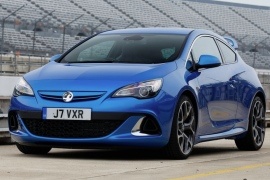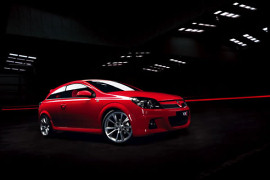VAUXHALL Astra VXR Models/Series Timeline, Specifications & Photos
First production year: 2005
Engines: Gasoline
Body style: Hatchback
In 2012, Vauxhall introduced the most potent version of the Astra lineup based on the GTC version and re-ignited the battle for the crown in the hot-hatch segment.
The GTC was the three-door version of the compact-segment Astra lineup. But it didn’t have the same overall shape as its five-door sibling, just with fewer doors. It looked sportier even in its basic engine configuration. Then, the automaker added all the ingredients to transform this hatchback into a proper hot hatch that could compete against the best in the business when it made the VXR version. In some aspects, it was the king of the segment.
When GM’s design team made the VXR and the OPC versions of the Astra for England and Europe, respectively, these cars had to look far more aggressive than their siblings. As a result, the vehicle featured a body-colored slat on the grille instead of a chromed one. Moreover, the bumper was specific for the VXR, featuring a deeper apron that integrated a broad air intake adorned by a honeycomb mesh grille. On the sides, flanking it, were two scoops that channeled air toward the front rotors to cool them.
With an already sporty-looking profile carried over from the GTC, Vauxhall had to find other ways to make the car look even more aggressive. As a result, it installed a new set of side sills and fitted the car with 19-inch wheels wrapped in 245/40 ZR tires on both axles. As an option, customers could get the Astra VXR with a set of 20-inch forged alloys. Since it was a high-performance compact vehicle, the automaker opted to lower the ground clearance for the VXR compared to the rest of the range. Finally, at the back, above the tailgate, the automaker installed a two-tier rear wing, which was available as part of the Aero Pack.
Inside, Vauxhall created a race-inspired cabin. While the base version featured bolstered seats, customers could opt for leather-wrapped sports seats with integrated headrests and cutouts for racing harnesses. In addition, the automaker added aluminum pedals that enhanced the car’s sporty character. Inside the instrument cluster, the VXR featured piano-black rings around the satin-black dials, contrasting with the red TFT display for the onboard computer placed between the speedometer and the tachometer. On the center console, the gear stick sported a piano-black trim adorned by the VXR badge. Last but not least, the steering wheel was unique for the VXR with its 360 mm (14-inch) diameter, which was 10 mm (0.4-inch) smaller than the one installed in the rest of the Astra range.
But the most significant upgrade of the VXR compared to the rest of the Astra GTC range was under its skin. The Brembo brake system with 355 mm (13.9-inch) diameter discs up front ensured customers the car could stop on a dime. Under the hood was a highly-tuned two-liter turbocharged gasoline engine that sent its 280 PS (276 hp) to the front wheels via a limited-slip differential provided by a racing specialist. In addition, the suspension setup was tuned by a proper racing driver, making the VXR one of the best-balanced cars in the hot hatch segment.
Vauxhall charged the hot hatch segment in 2005 in UK when it introduced the Astra VXR, challenging its competitors with a turbocharged engine and a seductive-looking car.
The British automaker carefully chose which bodywork version of the Astra should be used to make the VXR variant. It disregarded the five-door regular hatchback, which was Vauxhall’s competitor for the mundane Volkswagen Golf or the Renault Megane, and went straight to the GTC shape, which it considered to be more appropriate. With one of the best-looking three-door hatchbacks on the market and a potent engine under the hood, it thought that it couldn’t go wrong. Unfortunately, unlike Renault, it didn’t go the whole nine yards to install a limited-slip differential, so the car couldn’t put down all the oomph that it had, and it had plenty!
While it shared many body panels with the rest of the GTC version, the VXR had a few specific items that made it look different. It still had the same rhomboidal and swept-back headlights with projector beams, which looked good anyway. The grille, on the other hand, was different. It featured a honeycomb mesh, and instead of the chromed badge at its upper side, it had a body-color one. In addition, the lower bumper was more aggressive than the regular one from the Astra GTC. It sported the same hexagonal pattern on the lower grille and the side scoops that housed the fog lamps.
From its profile, the low-roof GTC bodywork was considered attractive by most young people, and not only. But unlike that model, the VXR featured deeper side skirts and wider wheel fenders that better matched the front apron’s look. At the back, the automaker added a roof spoiler at the top of the raked forward tailgate. Finally, the pieced de resistance was the mid-mounted exhaust that peaked through the rear apron. These distinctive elements made the car look sporty and, fortunately, matched the vehicle’s spirit.
Inside, Vauxhall installed a pair of Recaro sports seats at the front with high-bolstered areas that hugged their occupants. The automaker offered a few options for the interior, such as the three choices of displays atop the center stack for the onboard computer, where the highest version also featured a navigation system. Besides the aluminum-looking trims on the center stack, the automaker added carbon-fiber elements on the door cards, the dashboard, and the steering wheel. Fronting the driver was the same setup, with two large dials for the speedometer and tachometer, respectively, and the fuel gauge. On the center stack, the automaker installed the button for the adaptive suspension, which was a novelty for those times.
Under the hood, the automaker installed a turbocharged two-liter inline-four engine. It produced more power than its competitors, beating them in the horsepower war. Thanks to the six-speed manual gearbox, the car could also dominate some of them in the quarter-mile run. While it couldn’t become the king of drag strips, its attractive price and good look helped Vauxhall to sell many of them.

